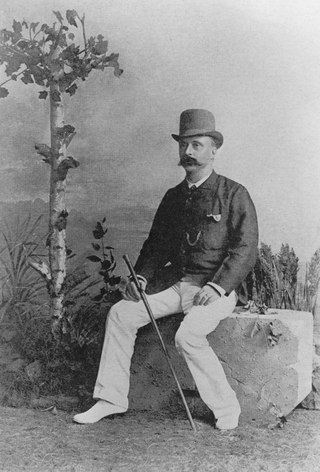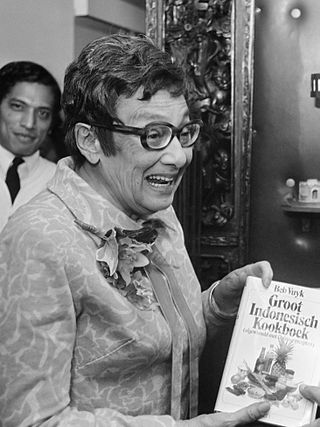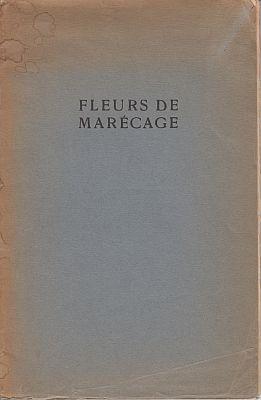
The Royal Netherlands East Indies Army was the military force maintained by the Kingdom of the Netherlands in its colony of the Dutch East Indies, in areas that are now part of Indonesia. The KNIL's air arm was the Royal Netherlands East Indies Army Air Force. Elements of the Royal Netherlands Navy and Government Navy were also stationed in the Netherlands East Indies.

Charles Edgar du Perron, more commonly known as E. du Perron, was an influential Dutch poet and author of Indo-European descent. He is best known for his literary acclaimed masterpiece Land van herkomst of 1935. Together with Menno ter Braak and Maurice Roelants he founded the short-lived but influential literary magazine Forum in 1932.
Tjalie Robinson is the main alias of the Indo (Eurasian) intellectual and writer Jan Boon also known as Vincent Mahieu. His father Cornelis Boon, a Royal Netherlands East Indies Army (KNIL) sergeant, was Dutch and his Indo-European mother Fela Robinson was part Scottish and Javanese.

Paulus Adrianus Daum, more commonly known as P. A. Daum, was a Dutch author of Dutch East Indies literature of the nineteenth century.

Pikiran Rakyat is a daily newspaper published in Bandung, West Java, Indonesia. Its circulation covers West Java and Banten Province.

Robert Nieuwenhuys was a Dutch writer of Indo descent. The son of a 'Totok' Dutchman and an Indo-European mother, he and his younger brother Roelof, grew up in Batavia, where his father was the managing director of the renowned Hotel des Indes.

Elizabeth (Beb) Vuyk was a Dutch writer of Indo (Eurasian) descent. Her Indo father was born in the Dutch East Indies and had a mother from Madura, but was ‘repatriated’ to the Netherlands on a very young age. She married into a typically Calvinist Dutch family and lived in the port city of Rotterdam. Vuyk grew up in the Netherlands and went to her father’s land of birth in 1929 at the age of 24. 3 years later she married Fernand de Willigen, a native born Indo that worked in the oil and tea plantations throughout the Indies. They had 2 sons, both born in the Dutch East Indies.
Hermanus (Herman) Berserik was a Dutch painter and print maker. He was a member of the Pulchri Studio in The Hague. He studied art at that city's Royal Academy of Art, where his teachers included Willem Schrofer, Willem Jacob Rozendaal, and Rein Draijer.

The Colony of Curaçao and Dependencies was a Dutch colony in the Caribbean Sea from 1815 until 1828 and from 1845 until 1954. Between 1936 and 1948, the area was officially known as the Territory of Curaçao, and after 1948 as the Netherlands Antilles. With the proclamation of the Charter for the Kingdom of the Netherlands on 15 December 1954, the Netherlands Antilles attained equal status with the Netherlands proper and Suriname in the new Kingdom of the Netherlands.

Indos are a Eurasian people of mixed Indonesian and European descent. The earliest evidence of Eurasian communities in the East Indies coincides with the arrival of Portuguese traders in the 16th century. Eurasian communities, often with distinct, specific names, also appeared following the arrival of Dutch (VOC) traders in the 17th and 18th century.

Annejet van der Zijl is a well-known and widely read writer in the Netherlands. So far, she has written seven non-fiction books and one fiction book, most of which have become bestsellers. Her work has been awarded the Gouden Ganzenveer and the Amsterdam Prize for the Arts.

The Bataviaasch Nieuwsblad was one of the leading and largest daily newspapers in the Dutch East Indies. It was based in Batavia on Java, but read throughout the archipelago. It was founded by the famous Dutch newspaperman and author P. A. Daum in 1885 and existed to 1957.

Severinus Desiré "Freek" Emanuels was a Surinamese politician, and Prime Minister of Suriname from 25 June 1958 to 30 June 1963.
Censorship in Indonesia has varied since the country declared its independence in 1945. For most of its history the government of Indonesia has not fully allowed free speech and has censored controversial, critical, or minority viewpoints, and during periods of crackdown it imprisoned writers and political activists. However, partly due to the weakness of the state and cultural factors, it has never been a country with full censorship where no critical voices were able to be printed or voiced.

Fleurs de Marécage is a collection of French poems by Dutch poet J. Slauerhoff, first published in 1929. Some are poems originally written in French, others are French translations by the poet of his originally Dutch poems.

Sin Po was a Peranakan Chinese Malay-language newspaper published in the Dutch East Indies and later Indonesia. It expressed the viewpoint of Chinese nationalism and defended the interests of Chinese Indonesians and was for several decades one of the most widely read Malay newspapers in the Indies. It existed under various names until 1965.

Jan Fabricius was a Dutch playwright and journalist. He was the father of Johan Fabricius, a writer. Although he wrote continuously from the 1890s to his death, his greatest period of success was during 1904-1916, when his plays sold out theatres in Rotterdam and were translated into multiple languages. During the height of his popularity he was considered by the Encyclopaedie van Nederlandsch-Indië to be the leading Dutch playwright writing plays set in the Indies.

Het Vrije Woord was a left-wing newspaper printed in the Dutch East Indies from 1915 to 1922, associated with the Indische Sociaal-Democratische Vereeniging and the Indonesian Communist Party in its early years.
Raden Pandji Wirasmo Notonindito, often referred to as Dr. Notonindito, was a Javanese accountant, intellectual and politician in the Dutch East Indies. He founded the short-lived Indonesian Fascist Party in 1933.
Censorship in the Dutch East Indies was significantly stricter than in the Netherlands, as the freedom of the press guaranteed in the Constitution of the Netherlands did not apply in the country's overseas colonies. Before the twentieth century, official censorship focused mainly on Dutch-language materials, aiming at protecting the trade and business interests of the colony and the reputation of colonial officials. In the early twentieth century, with the rise of Indonesian nationalism, censorship also encompassed materials printed in local languages such as Malay and Javanese, and enacted a repressive system of arrests, surveillance and deportations to combat anti-colonial sentiment.















